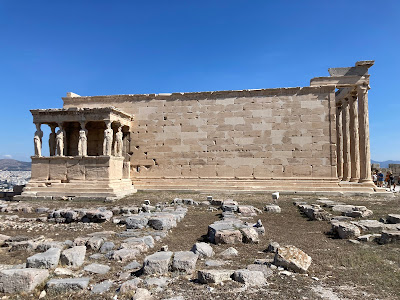And we shall assuredly not be without witnesses; there are mighty monuments of our power which will make us the wonder of this and of succeeding ages; we shall not need the praises of Homer or of amy other panegyrist whose poetry may please for the moment, although his representation of the facts will not bear the light of day. For we have compelled every land and every sea to open a path for our valor, and have everywhere planted eternal memorials of our friendship and of our enmity." - The Oration of Perikles from The Peloponnesian War.
The Acropolis of Athens arguably is one of the most instantly recognizable sites in the world. Rise above the city on a bluff of stone, crowned by the Parthenon which, even in decay, is magnificent, it remains one of the greatest legacies of the Athenian democracy - in this sense, Perikles son of Xanthippius' speech (or at least the words Thucydides speaks for him) were prophetic.
The Athenian Acropolis is, in and of itself, not unusual in that all Greek polis had an acro-polis, a high point well fortified as a fortress and point of last retreat in the event of invasion. And for thousands of years (as far back as 6,000 B.C.), people had lived here as it had two of the most important items for ancient survival: water and the ability to defend it. At one point during the Mycenean period, likely there was a palace located here and the plateau was fortified.
At some point - perhaps the 6th Centry B.C. - a temple to Athena was erected on the Acropolis as at some point in the past the purpose of the Acropolis slowly transitioned from a government center to a religious center. The architecture of this time is somewhat unknown, given all that was built up after it and the fact that - in 480 B.C. - the complex was effectively completely destroyed by the Persians in their invasion of Greece. The temples and statues were hauled down, the buildings burned.
In 447 B.C., as part of the expansion of the Athenian Democracy (and its empire), a series of building projects was undertaken resulting in the buildings that we have today. There are four major ones: The Parthenon (Temple of Athena), the Erechtheion, the Propylaia, and the temple of Athena Nike.
Everything that one reads on line informs one that the Acropolis will be 1) Crowded; and 2) Hot in Summer. Neither of these was incorrect. There is no shade on the Acropolis and the crowds, while definitely not unmanageable, were in abundance. The idea of getting a shot of anything there without people in it is a vain hope. An additional item is that pathway ascending the Acropolis, the stairs, and many parts of the Acropolis are paved in marble - slippery at best in good weather; probably a terror when it is wet.
Ascending from the base, one comes up through the Propylaia, the ceremonial entrance (built 437 B.C. to 432 B.C.). It remains imposing - as it was intended undoubtedly, showing off both Athenian power and as vestibule to the temple of the gods.
In the end of course, Perikles got his desire: likely few recall him or the great designers of these structures or the nameless workmen and slaves that built it; everyone recalls the glory of Athens that produced it.





















That's a lot of marble to be cut from the ground with only manpower to do it. Photos do back up what you said about all the locusts.....err.....people.
ReplyDeleteIt is a stunning testimony to getting something done Nylon12. The Athenian stone masons were probably some of the best in history.
DeleteAnd yes - from what our tour guide said, what we saw was not uncommon at all.
Sweet! Really gives perspective, eh?
ReplyDeleteI have toured the Parthenon with a roof and gold statue of Athena. But I toured the full scale replica in Nashville which was much less crowded and didn’t have as majestic of a view of its surroundings.
ReplyDelete